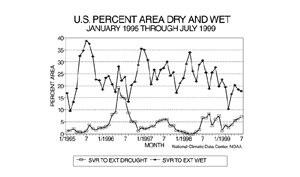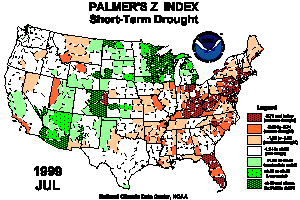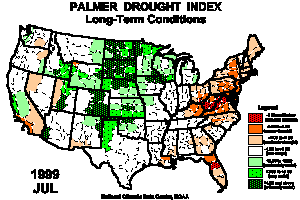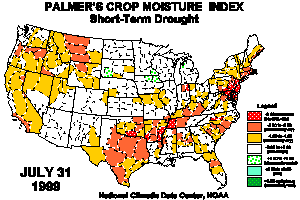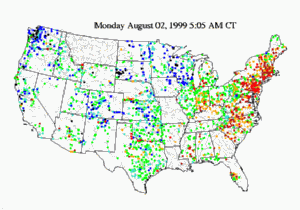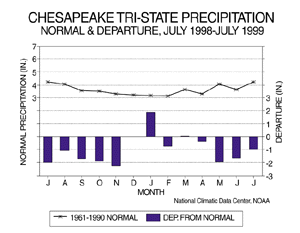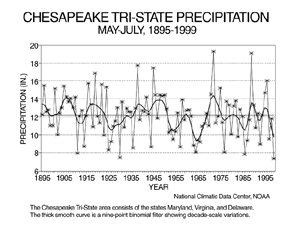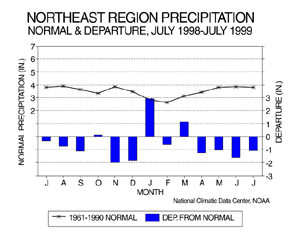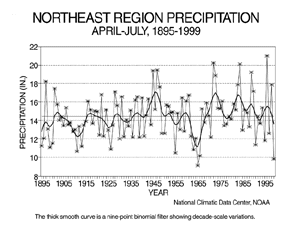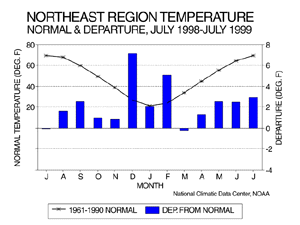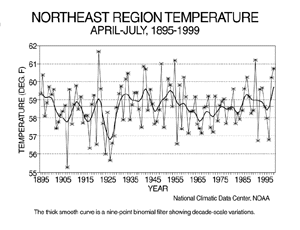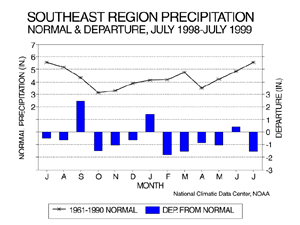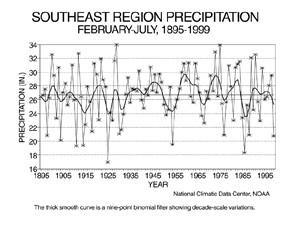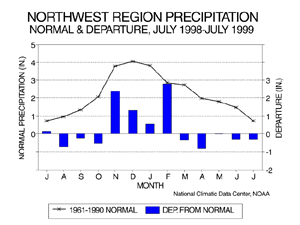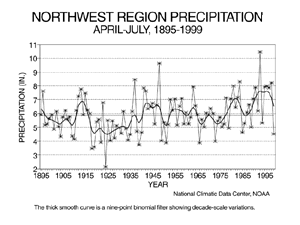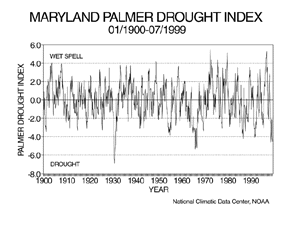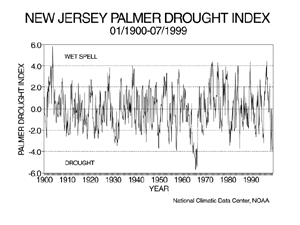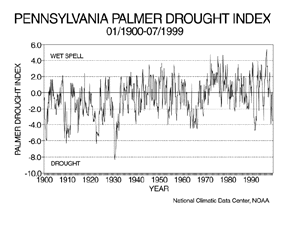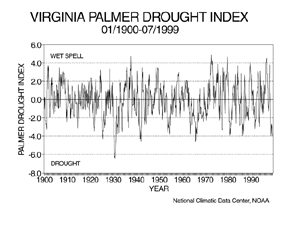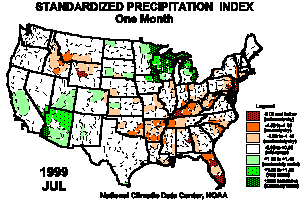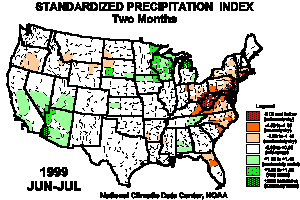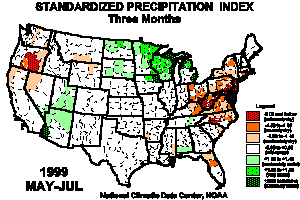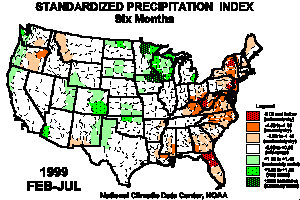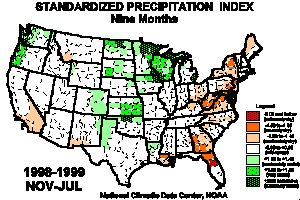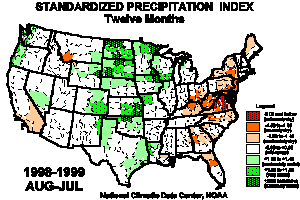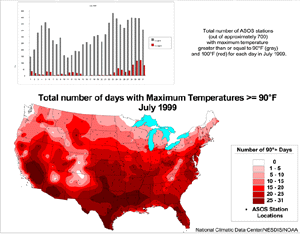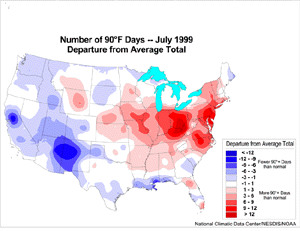During July 1999, the United States experienced an intensifying drought and heat wave. While it was not a national scale drought (it affected less than 10 percent of the country--see figure above), record and near-record short-term precipitation deficits occurred on a local and regional scale. As of early August, the governors of three states (Maryland, Pennsylvania, and New Jersey) had declared drought emergencies, with eleven localities in Virginia seeking federal disaster assistance. According to NOAA's Rapid Response Project, the Clinton Administration declared 88 counties of six states (Kentucky, Maryland, Ohio, Pennsylvania, Virginia and West Virginia) agricultural drought disaster areas, with monetary losses to farmers in just West Virginia expected to exceed $80 million. By mid-August, the Clinton administration had declared counties in three additional states (Connecticut, New Jersey, and New York) agricultural drought disaster areas. Crop impact information can be found at the USDA NASS (National Agricultural Statistics Service) and Weekly Weather and Crop Bulletin pages. Drought statements by local National Weather Service Offices can be found at the NWS Hydrologic Information Center. Drought threat assessments and other information can be found at NOAA's Drought Information Center. Additional drought information can be found at the National Drought Mitigation Center.
Palmer Drought Indices
The Palmer Z Index shows how monthly moisture conditions depart from normal (short-term drought and wetness). Much of the eastern third of the U.S. experienced severe to extreme short-term drought during July 1999, while extremely wet conditions stretched from the western Great Lakes to the Desert Southwest. The animated maps show the geographical pattern of the moisture anomalies for the last 12 months. On these maps, the red shading denotes dry conditions while the green shading indicates wet conditions.
The Palmer Drought Index Maps show long-term (cumulative) drought and wet conditions. The unusually dry conditions in July, combined with earlier dry months, resulted in long-term drought which stretched along the east coast from New England to Florida. Drought was especially severe in the mid-Atlantic states, where local water restrictions were in effect and drought emergencies had been declared by several governors. Much of the northern and central Plains and central Rockies continued in long-term wet spell conditions. The animated maps show how the geographical pattern of the long-term moisture conditions has changed over the last 12 months. On these maps, the red shading denotes drought conditions while the green shading indicates wet conditions.
The Palmer Crop Moisture Index is computed on a weekly basis by the National Weather Service's Climate Prediction Center and is useful for following the impact of precipitation anomalies on agriculture. The Animated Crop Moisture Index maps show the change in topsoil moisture conditions during the first 31 weeks of 1999. The CMI shows how short-term agricultural drought expanded and intensified during July from New England to Florida and Texas. The Far West also experienced growing agricultural drought from late June through July. On these Crop Moisture Index maps, the red shading denotes dry conditions while the green shading indicates wet conditions.
Drought and Streamflow
Streamflow measurements by the United States Geological Survey reveal unusually low daily streamflows associated with the drought from the mid-Atlantic to northeastern states during July. River stages were above normal during most of the month in the northern and central Plains. As noted by the Western Regional Climate Center, the above-normal streamflow in parts of the Pacific Northwest was likely due to runoff from ground saturated by very heavy winter snowpacks. Field reports from the Forest Service and the USDA's National Water & Climate Center indicate that there is still snow in the higher elevations and shaded areas of the Pacific Northwest mountains.
Explanation:

 New record high for day
New record high for day 90th percentile
90th percentile 75th - 89th percentile
75th - 89th percentile 25th - 74th percentile
25th - 74th percentile 10th - 24th percentile
10th - 24th percentile 10th percentile
10th percentile New record low for day
New record low for day
More streamflow information can be found at the United States Geological Survey's web page.
Regional Drought Watch
Mid-Atlantic Precipitation Deficit
The mid-Atlantic region (Chesapeake Bay area) continued to experience dry conditions in July, which exacerbated the long-term drought. This region has been suffering from drought since last summer. Ten of the last 13 months have been drier than normal, with seven months having precipitation departures of more than an inch below normal. May-July 1999 ranks as the driest May-July regionwide this century, barely bumping 1930 to second place. April-July 1999 ranks as the fourth driest such 4-month period, and the 12-month period, August 1998-July 1999, ranks as the second driest August-July on record. The second wettest August-July in this region, which occurred last year (1997-98), has helped prevent the current year's drought from having even greater impacts.
Northeastern U.S. Precipitation Deficit
The Northeast region (which includes the states from Delaware, Maryland, and Pennsylvania northeastward to Maine) has suffered from unusually dry conditions during the last four months. April-July 1999 ranked as the second driest such period this century, behind the record drought of the mid-1960's (1965 has the driest April-July). Ten of the last 13 months have been drier than normal. Unusually wet weather in January and March 1999 has helped keep the current year's drought from being more severe.
Northeastern U.S. Persistent Warmth
In addition to extreme dryness, the Northeast region has also experienced unusually persistent warm temperatures, with eleven of the last 12 months averaging above to much above normal. April-July 1999 ranked as the sixth warmest April-July on record, and August 1998-July 1999 ranked as the fifth warmest such 12-month period. Persistently warm temperatures increase the demand on water supplies in drought areas.
Southeast Region Precipitation Deficit
Ten of the last 13 months have averaged drier than normal across the Southeast region (Alabama to Florida, then northward to Virginia). February-July 1999 ranked as the seventh driest such period in the 105-year record, beating 1988 (which was the last year of a four-year Southeast drought). August 1998-July 1999 ranked as the 18th driest August-July on record.
Northwest Region Precipitation Deficit
Dry conditions during spring and summer 1999 in the Northwest region (Washington, Oregon, and Idaho) have resulted in expanding short-term drought (as measured by the Crop Moisture Index) into the region. April-July 1999 was the 17th driest April-July on record, and March-July 1999 was the 20th driest such 5-month period. However, the Pacific Northwest has a pronounced seasonal precipitation pattern, with November-March being the wet season. Water managers in this region are dependent on rivers fed by mountain snowpacks, which were unusually heavy this year due to the second wettest November-February on record.
Is This The Worst Drought on Record?
The Palmer Drought Index (PDI) has been used for U.S. drought monitoring for the last 30 years. It is based on a water budget model that incorporates the balance between water supply (i.e., precipitation), soil moisture, runoff, and water demand (computed from estimates for evaporation and transpiration). The PDI is a long-term drought index which incorporates the current conditions (i.e., for the current month) and the past conditions (the preceding several months). The PDI is useful for showing how the current drought compares to past droughts.
Plots of the monthly PDI for January 1900-July 1999 are shown below for Maryland, New Jersey, Pennsylvania, and Virginia. In all four cases, conditions during the past 12 months rapidly deteriorated into severe to extreme (PDI values of -3.0 to -4.0) long-term drought. However, the PDI indicates that the 1999 drought is not the worst long-term drought on record. In all states, the drought of the 1960's had a greater magnitude (more severe PDI level) and lasted much longer (three to four years). For three states, the worst drought (as measured by the magnitude of the PDI) occurred in 1930-31.
Standardized Precipitation Index
The Standardized Precipitation Index (SPI) is another way of measuring drought. The SPI is an index based on the probability of recording a given amount of precipitation. The probabilities are computed by mixing the likelihood of not receiving any precipitation, as in deserts, with the likelihood of receiving a given amount precipitation when precipitation falls. The probabilities are standardized so that an index of zero indicates the median precipitation amount (half of the historical precipitation amounts are below the median, and half are above the median). The index is negative for drought, and positive for wet conditions. As the dry or wet conditions become more severe, the index becomes more negative or positive. While the Palmer Drought Index is a water balance index that considers water supply (precipitation), demand (evapotranspiration) and loss (runoff), the SPI is a probability index that considers only precipitation.
The six maps below show the July 1999 spatial patterns of SPI for six different time frames ranging from one month (short-term conditions) to twelve months (long-term conditions). When taken together, they give a combined geographical and temporal picture of the severity of the precipitation deficits. The maps indicate, for example, that the eastern third of the U.S. has been experiencing both recent short-term dryness and dryness over the long term (past year), the dryness in the Northwest is a recent (back to six months) phenomenon, parts of the Southwest have been dry over the long term (12 months) but have been wet recently, and the central U.S. has been wet over the long term and also wet (in parts, especially the western Great Lakes) recently.
The July 1999 Heat Wave
Unusually hot temperatures occurred with the drought in the eastern U.S. The map to the left below shows the geographical pattern of number of days with maximum temperatures of 90 degrees F or above in July 1999. The 90 degree days dominated the southern tier states, which is common in the summer. The bar graph above the map shows two distinct heat waves during the month. The heat wave that started about July 22nd built upon itself, with more stations reaching 100 degree temperatures (red bars) each day as the month drew to a close. A list of stations setting new temperature records can be found at NCDC's July station extremes page.
The map to the right below shows the geographical pattern of the departure of these 90+ degree days from the 1961-1990 normal. Even though much of the Deep South had more than half of the month with 90+ degree days, such hot days are usual for this area, with parts of the Gulf Coast even having fewer than normal such days. The areas hardest hit by unusual warmth (red shading) stretched from the mid-Mississippi Valley to the mid-Atlantic states, then northward to New England. The unusually dry conditions over much of this area were compounded by excessively hot temperatures, thus exacerbating the drought.
Current data are based on preliminary reports from River Forecast Center stations and First and Second Order airport stations obtained from the National Weather Service (NWS) Climate Prediction Center and real time Global Telecommunications System (GTS) monthly CLIMAT summaries. THE CURRENT DATA SHOULD BE USED WITH CAUTION. These preliminary data are useful for estimating how current anomalies compare to the historical record, however the actual values and rankings for the current year may change as the final data arrive at NCDC and are processed.
The following NCDC datasets are used for the historical U.S. data: the climate division drought database (TD-9640), and the hurricane datasets (TD-9636 and TD-9697). It should be noted that the climate division drought database consists of monthly data for 344 climate divisions in the contiguous United States. These divisional values are calculated from the 6000+ station Cooperative Observer network.
 NOAA's National Centers for Environmental Information
NOAA's National Centers for Environmental Information
